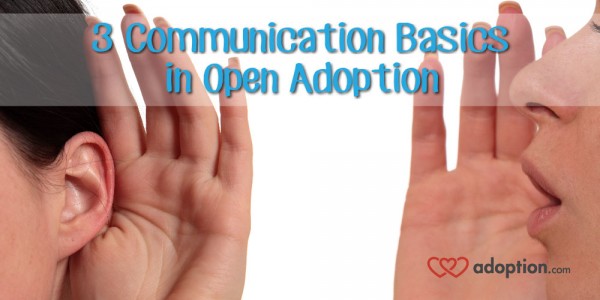Communication is key. While this adage has become a cliché, those words remain true of all relationships. Because the relationships within open adoption are especially complex, maintaining good communication skills is even more important. Unfortunately, many people take the ability to communicate for granted and thereby cause tension in their relationships. If you find that the lines have become tied between yourself and another member of your open adoption, consider these three communication basics:
1. Speaking
Whether you intend to break the ice, bring up a sensitive point, or even simply converse, being the first to speak is a daunting task. What you say and how you say it will set the mood for the rest of the interaction and will affect your entire relationship, after all. But that doesn’t mean you shouldn’t do it.
Many people speak from their own context and perspective. This is expected because we know and understand our perspective better than anyone else’s. Our understanding itself is housed in our perspective. However, these differences in context are reflected in language, and thus, conversation. The best way to remedy this difference is by becoming receiver-oriented.
The concept of choosing the right words for an audience is simple in theory. The application is a little harder. In open adoption, approaching a conversation from the other party’s perspective may prove very helpful to improving relations. Four Hot-Button Words to Use Carefully in Open Adoption illustrates the effect pronouns can have on different audiences in adoption.
2. Listening
If one observes language closely–especially in a familiar context–the listening skills of most people are rather poor. In a face-to-face conversation or telephone call, we are conditioned to respond fairly soon after the other party finishes their statement. Pauses are usually considered awkward, and most people will do anything to avoid them. In fact, journalists and reporters often strategically facilitate awkward silences so that the person they are interviewing will fill it.
Rather than spend the time another party is using to formulate your own response, silence yourself internally and listen. Listen to tone, context, and words. Listening takes an astonishing amount of discipline. But when paired with understanding, listening to another can shape how you view the situation and people involved in the adoption.
Because open adoption is very often a series of distanced relationships, the words exchanged are highly valuable. From them, we base our assumptions about others and confirm or dispel prior ideas. If you have chosen your words carefully, consider that the other party has, as well. Give their words the attention they deserve.
3. Responding
Listening would be much easier if we could do so without the concerns of crafting a response. If you have spent your time listening, you will probably find yourself sitting in the feared awkward silence. Nonetheless, responding is your opportunity to demonstrate that you’ve been listening.
Because we are given such little time for response in a conversation, most people use tactics to postpone. These include asking clarifying questions, laughing (when appropriate), appearing thoughtful, or even using the environment to deflect momentarily (such as tying a shoe or sipping a drink). Realize that using these tactics before responding to a tricky question or statement is actually a great idea.
When you do respond, though, be sure to orient what you’re saying around what was just said. Make sure it’s relevant. Sometimes, when a person was previously unable to continue a thought, they may carry on and finish it as a response. Usually, when one person does this, the other will as well. This kills the conversation and turns it into two separate monologues; you are no longer interactively speaking. Be sure to allow the other person to finish their thought before you respond.
Adapting your language patterns is very difficult at first. However, given time and practice, communicating effectively will become intuitive. Communication isn’t necessarily about “filtering” out what one really needs to say; it simply gives a vehicle for how one says it. In order to keep the lines open in adoption, be sure to maintain your own communication skills. For more on nurturing relationships in open adoptions, check out Building Bridges in Open Adoption.

